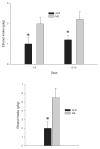Genetic and environmental influences on ethanol consumption: perspectives from preclinical research
- PMID: 20374217
- PMCID: PMC4404761
- DOI: 10.1111/j.1530-0277.2010.01172.x
Genetic and environmental influences on ethanol consumption: perspectives from preclinical research
Abstract
Background: Alcohol use disorders (abuse and dependence, AUD) are multifactorial phenomena, depending on the interplay of environmental and genetic variables.
Method: This review describes current developments in animal research that may help (a) develop gene therapies for the treatment of alcoholism, (b) understand the permissive role of stress on ethanol intake, and (c) elucidate why exposure to ethanol early in life is associated with a greater risk of AUD.
Results: The polymorphisms found in liver alcohol dehydrogenase (ADH) and aldehyde dehydrogenase (ALDH) affect the elimination of ethanol and the susceptibility to ethanol intake. A highly active ADH protects against alcoholism, an effect related to a presteady state burst in arterial acetaldehyde. Social stressors, such as repeated early maternal separation or social defeat, exert a permissive effect on ethanol intake, perhaps by altering the normal development of the hypothalamic-pituitary-adrenal axis. Ethanol exposure during gestation, infancy, or adolescence increases the likelihood of AUD later in life. Early perception of ethanol's positive and negative (anti-anxiety) reinforcing effects may play a role in this phenomenon.
Conclusions: The review underscores the advantages of using preclinical animal models of AUD and highlights points of intersection between the topics to help design a more integrated approach for the study of alcohol-related problems.
Figures


Similar articles
-
Social defeat in adolescent mice increases vulnerability to alcohol consumption.Addict Biol. 2016 Jan;21(1):87-97. doi: 10.1111/adb.12184. Epub 2014 Sep 14. Addict Biol. 2016. PMID: 25219790
-
The limbic-hypothalamic-pituitary-adrenal axis and the development of alcohol use disorders in youth.Alcohol Clin Exp Res. 2011 Apr;35(4):595-605. doi: 10.1111/j.1530-0277.2010.01380.x. Epub 2011 Jan 11. Alcohol Clin Exp Res. 2011. PMID: 21223300 Free PMC article. Review.
-
Sex differences, alcohol dehydrogenase, acetaldehyde burst, and aversion to ethanol in the rat: a systems perspective.Am J Physiol Endocrinol Metab. 2007 Aug;293(2):E531-7. doi: 10.1152/ajpendo.00187.2007. Epub 2007 May 8. Am J Physiol Endocrinol Metab. 2007. PMID: 17488809
-
Effects of moderate alcohol consumption on the central nervous system.Alcohol Clin Exp Res. 1998 Aug;22(5):998-1040. doi: 10.1111/j.1530-0277.1998.tb03695.x. Alcohol Clin Exp Res. 1998. PMID: 9726269 Review.
-
Effect of different stressors on voluntary ethanol intake in ethanol-dependent and nondependent C57BL/6J mice.Alcohol. 2016 Mar;51:17-23. doi: 10.1016/j.alcohol.2015.11.010. Epub 2016 Jan 20. Alcohol. 2016. PMID: 26992696 Free PMC article.
Cited by
-
A Genetic Animal Model of Alcoholism for Screening Medications to Treat Addiction.Int Rev Neurobiol. 2016;126:179-261. doi: 10.1016/bs.irn.2016.02.017. Epub 2016 Mar 21. Int Rev Neurobiol. 2016. PMID: 27055615 Free PMC article. Review.
-
Ethanol concentration-dependent effects and the role of stress on ethanol drinking in corticotropin-releasing factor type 1 and double type 1 and 2 receptor knockout mice.Psychopharmacology (Berl). 2011 Nov;218(1):169-77. doi: 10.1007/s00213-011-2284-6. Epub 2011 Apr 13. Psychopharmacology (Berl). 2011. PMID: 21487655 Free PMC article.
-
Relationship between ethanol-induced activity and anxiolysis in the open field, elevated plus maze, light-dark box, and ethanol intake in adolescent rats.Behav Brain Res. 2014 May 15;265:203-15. doi: 10.1016/j.bbr.2014.02.032. Epub 2014 Feb 28. Behav Brain Res. 2014. PMID: 24583190 Free PMC article.
-
μ-Opioid blockade reduces ethanol effects on intake and behavior of the infant rat during short-term but not long-term social isolation.Pharmacol Biochem Behav. 2013 Feb;103(4):773-82. doi: 10.1016/j.pbb.2012.11.008. Epub 2012 Nov 23. Pharmacol Biochem Behav. 2013. PMID: 23182856 Free PMC article.
-
Effect of voluntary alcohol consumption on Maoa expression in the mesocorticolimbic brain of adult male rats previously exposed to prolonged maternal separation.Transl Psychiatry. 2015 Dec 8;5(12):e690. doi: 10.1038/tp.2015.186. Transl Psychiatry. 2015. PMID: 26645625 Free PMC article.
References
-
- Abate P, Pepino M, Dominguez H, Spear N, Molina J. Fetal associative learning mediated through maternal alcohol intoxication. Alcohol Clin Exp Res. 2000;24:39–47. - PubMed
-
- Abate P, Pepino M, Spear N, Molina J. Fetal learning with ethanol: correlations between maternal hypothermia during pregnancy and neonatal responsiveness to chemosensory cues of the drug. Alcohol Clin Exp Res. 2004;28:805–815. - PubMed
-
- Araujo NP, Camarini R, Souza-Formigoni MLO, Carvalho RC, Ablio VC, Silva RH, Ricardo VP, Ribeiro RdA, Frussa-Filho R. The importance of housing conditions on behavioral sensitization and tolerance to ethanol. Pharmacol Biochem Behav. 2005;82:40–45. - PubMed
-
- Arolfo MP, Overstreet DH, Yao L, Fan P, Lawrence AJ, Tao G, Keung W-M, Vallee BL, Olive MF, Gass JT, Rubin E, Anni H, Hodge CW, Besheer J, Zablocki J, Leung K, Blackburn BK, Lange LG, Diamond I. Suppression of heavy drinking and alcohol seeking by a selective ALDH-2 inhibitor. Alcohol Clin Exp Res. 2009;33:1–10. - PMC - PubMed
Publication types
MeSH terms
Grants and funding
LinkOut - more resources
Full Text Sources
Medical

